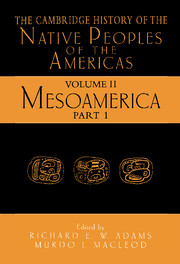Book contents
- Frontmatter
- Contents
- List of Illustrations
- Part I
- 1 Introduction to a Survey of the Native Prehistoric Cultures of Mesoamerica
- 2 The Paleoindian and Archaic Cultures of Mesoamerica
- 3 The Preclassic Societies of the Central Highlands of Mesoamerica
- 4 The Precolumbian Cultures of the Gulf Coast
- 5 The Maya Lowlands: Pioneer Farmers to Merchant Princes
- 6 The Central Mexican Highlands from the Rise of Teotihuacan to the Decline of Tula
- 7 Western and Northwestern Mexico
- 8 Cultural Evolution in Oaxaca: The Origins of the Zapotec and Mixtec Civilizations
- 9 The Southeast Frontiers of Mesoamerica
- 10 The Maya Highlands and the Adjacent Pacific Coast
- 11 The Aztecs and Their Contemporaries: The Central and Eastern Mexican Highlands
- Index
8 - Cultural Evolution in Oaxaca: The Origins of the Zapotec and Mixtec Civilizations
Published online by Cambridge University Press: 28 March 2008
- Frontmatter
- Contents
- List of Illustrations
- Part I
- 1 Introduction to a Survey of the Native Prehistoric Cultures of Mesoamerica
- 2 The Paleoindian and Archaic Cultures of Mesoamerica
- 3 The Preclassic Societies of the Central Highlands of Mesoamerica
- 4 The Precolumbian Cultures of the Gulf Coast
- 5 The Maya Lowlands: Pioneer Farmers to Merchant Princes
- 6 The Central Mexican Highlands from the Rise of Teotihuacan to the Decline of Tula
- 7 Western and Northwestern Mexico
- 8 Cultural Evolution in Oaxaca: The Origins of the Zapotec and Mixtec Civilizations
- 9 The Southeast Frontiers of Mesoamerica
- 10 The Maya Highlands and the Adjacent Pacific Coast
- 11 The Aztecs and Their Contemporaries: The Central and Eastern Mexican Highlands
- Index
Summary
THE NATURE OF OAXACA PREHISTORY
South of Mexico City, the eastern and western sierras madres slowly converge to form a massive block called the Oaxaca highlands. In contrast to the broad, open basins of Central Mexico, this landscape consists mainly of narrow canyons and alluvial river valleys surrounded by rugged mountains. The cooler, pine-forested peaks receive moisture from both the Atlantic and Pacific, and deliver it to the lower, drier valleys in the form of springs and streams.
These valleys vary greatly in size and altitude, with the largest being the semitropical Valley of Oaxaca (Map 8.1). Shaped like a Y or threepointed star, this valley has 2,000 square kilometers of alluvial floor, gentle piedmont, and higher mountain slopes. Oaxaca lies at 1,550 meters above sea level and receives an average of 550 millimeters of rain, concentrated in the summer. Before it was cleared for agriculture, the valley would have had alder, willow, and baldcypress along the Atoyac River and its tributaries; an open woodland of mesquite and grass on its alluvial plains; thickets of cactus, agaves, and thorny legume trees on its piedmont; and forests of oak and pine on the mountains, which rise to 2,500 meters. It seems to have been in this large, broad valley that Zapotec civilization began, but that culture eventually spread both into the sierras north of the valley and to the tropical Tehuantepec coast on the southeast.
To the west lie a whole series of smaller valleys where Mixtec civilization began. The central part of this region, called the Mixteca Alta, consists of high, temperate valleys like that of Tilantongo and Yanhuitlán–Nochixtlán, with alluvial floors at 2,000 meters elevation and humid, pine-forested mountains above them. The northern part, called the Mixteca Baja, consists of lower semitropical valleys like Tequixtepec and Huajuapan, with alluvial floors at 1,000–1,500 meters elevation and drier, thorn-forested mountains above them. The southern part of this region is the Mixteca de la Costa, an area on the Pacific Coast where sites like Tututepec rise out of hot, tropical deciduous forest.
The Mixtec and Zapotec speak languages of the Otomanguean family, and both tongues probably evolved from a common ancestor that existed somewhere in the Oaxaca region before 4000 B.C.
- Type
- Chapter
- Information
- The Cambridge History of the Native Peoples of the Americas , pp. 358 - 406Publisher: Cambridge University PressPrint publication year: 2000
- 4
- Cited by



